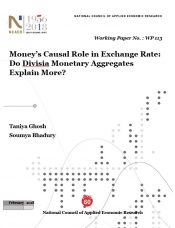Money's Causal Role in Exchange Rate: Do Divisia Monetary Aggregates Explain More?
Soumya Bhadury
Taniya Ghosh
February 2018
We investigate the predictive power of Divisia monetary aggregates in explaining exchange rate variations for India, Israel, Poland, UK and the US, in the years leading up to and following the 2007-08 recessions. One valid concern for the chosen sample period is that the interest rate has been stuck at or near the zero lower bound (ZLB) for some major economies. Consequently, the interest rate has become uninformative about the monetary policy stance. An important innovation in our research is to adopt the Divisia monetary aggregate as an alternative to the policy indicator variable. We apply bootstrap Granger causality method which is robust to the presence of non-stationarity in our data. Additionally, we use bootstrap rolling window estimates to account for the problems of parameter non-constancy and structural breaks in our sample covering the Great recession. We find strong causality from Divisia money to exchange rates. By capturing the time-varying link of Divisia money to exchange rate, the importance of Divisia is further established at ZLB.
National Growth and Macroeconomic Centre







